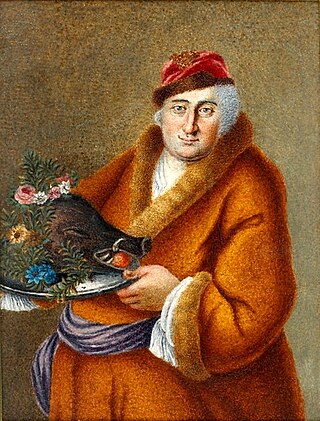
Frumenty was a popular dish in Western European medieval cuisine. It is a porridge, a thick boiled grain dish—hence its name, which derives from the Latin word frumentum, "grain". It was usually made with cracked wheat boiled with either milk or broth and was a peasant staple. More luxurious recipes include eggs, almonds, currants, sugar, saffron and orange flower water. Frumenty was served with meat as a pottage, traditionally with venison or even porpoise. It was also frequently used as a subtlety, a dish between courses at a banquet.

Addington Palace is an 18th-century mansion in Addington located within the London Borough of Croydon. It was built close to the site of an earlier manor house belonging to the Leigh family. It is particularly known for having been, between 1807 and 1897, the summer residence of the Archbishops of Canterbury. Since the 1930s most of the grounds have been occupied by Addington Palace Golf Club. Between 1953 and 1996 the mansion was occupied by the Royal School of Church Music, which has since moved to Salisbury. It was later used as a wedding and events venue.

Louisiana Creole cuisine is a style of cooking originating in Louisiana, United States, which blends West African, French, Spanish, and Native American influences, as well as influences from the general cuisine of the Southern United States.
Black soup was a regional cuisine of ancient Sparta, made with boiled pork meat and blood, using only salt and vinegar to flavour. The soup was well known during antiquity in the Greek world, but no original recipe of the dish survives today. The earliest recorded mention of the soup can be dated to the fifth century BC, in a comedy titled The Miners, written by Pherecrates. The ancient sources provide contradictory accounts on whether the soup was a luxurious meal served only at banquets or a dish that could be afforded by all Spartiates. Throughout history, black soup has been praised by and associated with figures such as Benjamin Rush and Adolf Hitler, although Hitler was (debatably) vegetarian.

Pease pudding, also known as pease porridge, is a savoury pudding dish made of boiled legumes, typically split yellow peas, with water, salt and spices, and often cooked with a bacon or ham joint. A common dish in the north-east of England, it is consumed to a lesser extent in the rest of Britain. In Newfoundland, it retains its traditional name as part of the customary Jiggs dinner. In non-English speaking countries, similar dishes exist under different names.

Under feudalism in France and England during the Middle Ages, tenure by serjeanty was a form of tenure in return for a specified duty other than standard knight-service.
The Manor of Worksop is a feudal entity in the Dukeries area of Nottinghamshire, England. Held in Grand Serjeanty by a lord of the manor, it was originally connected with nearby Worksop Manor, a stately home.

Scrivelsby is a village and ecclesiastical parish in the East Lindsey district of the County of Lincolnshire, England. It is situated 2 miles (3.2 km) south of Horncastle and is on the B1183 road 1 mile (1.6 km) east from the A153 road. It is administered by the civil parish of Mareham on the Hill.

Mujaddara is a dish consisting of cooked lentils together with groats, generally rice, and garnished with sautéed onions. It is especially popular in the Levant.

Afghan cuisine is influenced by Persian, Central Asian, and South Asian cuisines due to Afghanistan's close proximity and cultural ties. The cuisine is halal and mainly based on mutton, beef, poultry and fish with rice and Afghan bread. Accompanying these are common vegetables and dairy products, such as milk, yogurt, whey, and fresh and dried fruits such as apples, apricots, grapes, bananas, oranges, plums, pomegranates, sweet melons, and raisins. The diet of most Afghans revolves around rice-based dishes, while various forms of naan are consumed with most meals. Tea is generally consumed daily in large quantities, and is a major part of hospitality. The culinary specialties reflect the nation's ethnic and geographic diversity. The national dish of Afghanistan is Kabuli palaw, a rice dish cooked with raisins, carrots, nuts, and lamb or beef.

Pottage or potage is a term for a thick soup or stew made by boiling vegetables, grains, and, if available, meat or fish. It was a staple food for many centuries. The word pottage comes from the same Old French root as potage, which is a dish of more recent origin.

The Closet of the Eminently Learned Sir Kenelme Digbie Kt. Opened, commonly known as The Closet Opened, is an English cookery book first printed in 1669. The title page states that it is based upon the writings of Sir Kenelm Digby, "published by his son's consent".

Nigerian cuisine consists of dishes or food items from the hundreds of Native African ethnic groups that comprises Nigeria. Like other West African cuisines, it uses spices and herbs with palm oil or groundnut oil to create deeply flavored sauces and soups.

The Accomplisht Cook is an English cookery book published by the professional cook Robert May in 1660, and the first to group recipes logically into 24 sections. It was much the largest cookery book in England up to that time, providing numerous recipes for boiling, roasting, and frying meat, and others for salads, puddings, sauces, and baking. Eight of the sections are devoted to fish, with separate sections for carp, pike, salmon, sturgeon, and shellfish. Another section covers only eggs; and the next only artichokes.

Baron Bardolf or Bardolph was a title in the Peerage of England.

Paul Tremo was the head chef at the court of King Stanislaus Augustus Poniatowski of Poland. He was born in Berlin, in a family of French Huguenots. As the king's favourite cook, he was responsible for the culinary side of royal banquets, including Thursday Dinners to which Stanislaus Augustus invited Warsaw's leading intellectuals. He followed the king to Saint Petersburg after the latter's abdication in 1795, but returned to Warsaw after his death in 1798. His cooking style combined Polish, French and other west European influences. As a mentor to aspirant Polish chefs and author of recipes which circulated in handwritten copies, he was instrumental in the development of modern Polish cuisine that was more moderate and cosmopolitan than old Polish cookery.

A History of English Food is a 2011 non-fiction book, a history of English cuisine arranged by period from the Middle Ages to the end of the twentieth century, written by the celebrity cook Clarissa Dickson Wright and published in London by Random House. Each period is treated in turn with a chapter. The text combines history, recipes, and anecdotes, and is illustrated with 32 pages of colour plates.
A mortis, also spelt mortrose, mortress, mortrews, or mortruys, was a sweet pâté of a meat such as chicken or fish, mixed with ground almonds, made in Medieval, Tudor and Elizabethan era England. It is known from one of England's earliest cookery books, The Forme of Cury (1390), and other manuscripts.
Soup and Bouilli in England is a dish of boiled beef and root vegetables based on the traditional French dish pot-au-feu. The name comes from the general method in France of serving pot-au-feu as two courses—la soupe et le bouilli. In England as in France, bouilli referred to the boiled meat.















